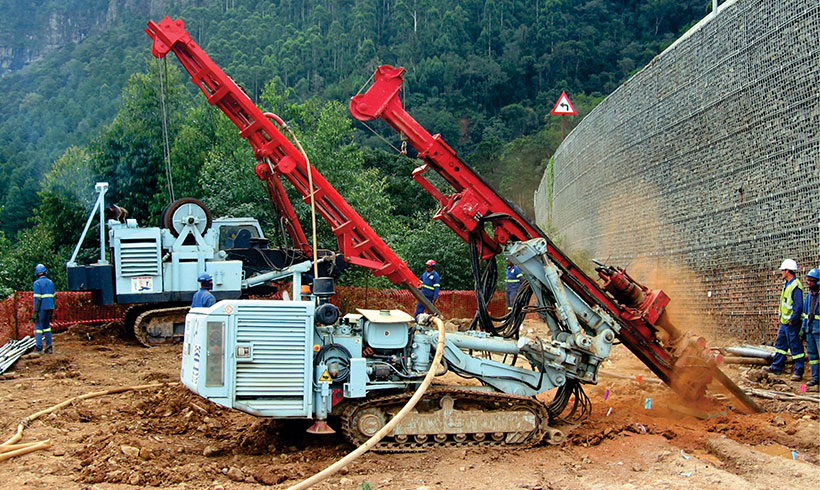Geotechnical Engineering For Construction Projects - Questions
The smart Trick of Geotechnical Engineering For Construction Projects That Nobody is Talking About
Table of ContentsWhat Does Geotechnical Engineering For Construction Projects Mean?The Of Geotechnical Engineering For Construction ProjectsA Biased View of Geotechnical Engineering For Construction ProjectsThe Best Strategy To Use For Geotechnical Engineering For Construction Projects3 Easy Facts About Geotechnical Engineering For Construction Projects ShownGeotechnical Engineering For Construction Projects Things To Know Before You Get This
The duty of geotechnical design considerably takes care of realizing the functions of dirt and rock, which may vary significantly by their density, dampness material etc. These functions have to be examined by geotechnical designers to forecast their movements under different circumstances. The security along with security of frameworks are affected by dirt problems, making this analysis necessary., in enhancement to how they communicate with building and constructions that have been set up on or within them, is one of the key descriptions for why geotechnical engineering is crucial.
Along with structural preparation and building, geotechnical design is also crucial to the reconstruction and upkeep of pre-existing frameworks. Age-related degradation or additional issues might impact a structure's stability and efficiency. Environmental management is achieved via geotechnical engineering. Knowledge in air, water, and soil high quality upkeep is used by geotechnical engineers to lessen the unfavorable impacts of jobs.
Framework development, offshore engineering, tunnel building, and deep structures. Risk-based layout and multidisciplinary teams. These elements will maintain the field developing and guarantee its continued significance in the years to find. To summarize, geotechnical design is a vital discipline that maintains the strength and stability of civil framework. Geotechnical designers add to making building tasks efficient throughout the globe by understanding the practices of earth products and using proper planning approaches.
The Ultimate Guide To Geotechnical Engineering For Construction Projects
The fundamental stability of any job is vital. Geotechnical engineering plays a crucial duty in guaranteeing that structures are built on solid ground, literally and figuratively. By checking out dirt, rock, and subsurface problems, geotechnical designers provide crucial insights that assist in the layout, building and construction, and upkeep of buildings and infrastructure.

Geotechnical Engineering For Construction Projects Fundamentals Explained
Research laboratory screening: Establishing the homes of dirt and rock. visit this site right here Area screening: Carrying out tests on-site to evaluate problems. Analysis and design: Using information to make structures, retaining wall surfaces, tunnels, and various other frameworks. Several high-profile building projects have successfully used geotechnical engineering to ensure their security and safety and security. For circumstances:: The globe's tallest building called for a deep understanding of the underlying geology.

As a leader in geotechnical engineering, BECC Inc. is devoted to providing ingenious and effective services that fulfill the highest criteria of quality and security., a mechanical designer and geologist.
7 Simple Techniques For Geotechnical Engineering For Construction Projects
Terzaghi likewise developed the framework for theories of bearing ability of foundations, and the concept for forecast of the price of settlement of clay layers because of consolidation. After that, More Help Maurice Biot fully developed the three-dimensional soil consolidation concept, expanding the one-dimensional design previously developed by Terzaghi to much more general hypotheses and presenting the set of fundamental formulas of Poroelasticity.
Geotechnical engineers examine and identify the residential or commercial properties of subsurface problems and products.
Some Known Facts About Geotechnical Engineering For Construction Projects.
Geologic mapping and interpretation of geomorphology are commonly finished in consultation with a geologist or engineering geologist. Subsurface exploration normally entails in-situ screening (for example, the conventional penetration test and cone infiltration test). The excavating of examination pits and trenching (specifically for locating mistakes and slide planes) may additionally be made use of to find out regarding soil problems at depth. , which uses a thick-walled split spoon sampler, is the most typical way to gather disrupted samples.

Usually, the user interface's specific geometry is unknown, and a streamlined user interface geometry is presumed. Limited inclines need three-dimensional versions to be evaluated, so most slopes are evaluated assuming that they are definitely wide and can be represented by two-dimensional versions.
Geotechnical Engineering For Construction Projects for Beginners
Producing the style based on a functioning theory of behavior expected under the most probable conditions. Choice of quantities to be observed as construction proceeds and calculating their expected worths based on the working hypothesis under the most undesirable conditions.
Dimension of quantities and examination of real conditions. Design alteration per actual problems The empirical method is ideal for construction that has already started when an unexpected development takes place or when a failing or accident looms or has actually currently taken place. It basics is inappropriate for jobs whose style can not be altered during building and construction.